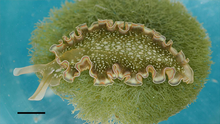
Prasiola is a genus of fresh water and marine green algae. Each individual plant is small but they usually grow side by side to form a green turf on rock surfaces. The genus has a cosmopolitan distribution.

The Fucales (fucoids) are an order in the brown algae. The list of families in the Fucales, as well as additional taxonomic information on algae, is publicly accessible at Algaebase.

AlgaeBase is a global species database of information on all groups of algae, both marine and freshwater, as well as sea-grass.

Fire corals (Millepora) are a genus of colonial marine organisms that exhibit physical characteristics similar to that of coral. The name coral is somewhat misleading, as fire corals are not true corals but are instead more closely related to Hydra and other hydrozoans, making them hydrocorals. They make up the only genus in the monotypic family Milleporidae.
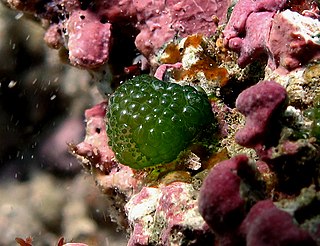
Dictyosphaeria is a genus of green algae in the family Siphonocladaceae.

Seaweed, or macroalgae, refers to thousands of species of macroscopic, multicellular, marine algae. The term includes some types of Rhodophyta (red), Phaeophyta (brown) and Chlorophyta (green) macroalgae. Seaweed species such as kelps provide essential nursery habitat for fisheries and other marine species and thus protect food sources; other species, such as planktonic algae, play a vital role in capturing carbon, producing at least 50% of Earth's oxygen.

The Ancillariidae is a taxonomic family of sea snails, marine gastropod molluscs in the superfamily Olivoidea. They are gastropods, which belong to the larger group of mollusks. This family is part of the superfamily Cypraeoidea, which includes cowries, a well-known group of sea snails.
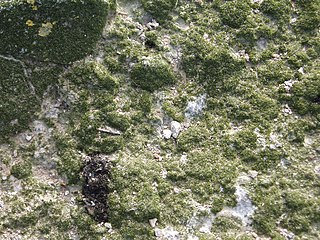
Prasiola stipitata is a small green alga.

Udotea flabellum is a species of photosynthetic macroalgae. It is commonly found in shallow waters around Florida and Belize in sandy areas, sea grass beds, and coral reefs. It is known for its antimicrobial properties and is also being used in cancer treatment studies.

Rissoella verruculosa is a species of red algae, the only accepted species in the genus Risoella and the family Rissoellaceae. This species is endemic to the Mediterranean Sea.

Prasiola calophylla is a species of algae.

Naccariaceae is a family of red algae in the order Bonnemaisoniales, with 3 monotypic genera that are found in both the Pacific and Atlantic Oceans.

Sargassum polyphyllum is a species of brown macroalgae or limu (seaweed) in the order Fucales.
Padina sanctae-crucis is a species of brown macroalgae in the family Dictyotaceae. It is a tropical brown algae species native to the south pacific that belongs to the Padina genus. this alga includes sexual reproduction and spore-producing asexual reproduction which is moved with the tide until spores plants itself on a hard rocky substrate. Other habitats include rocks and shell fragments in the shallow sublittoral, seagrass meadows, mangrove roots and coral reefs on tidal flats.
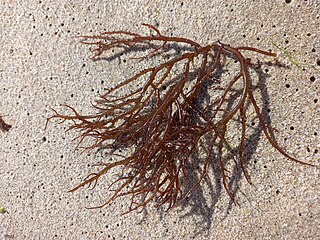
Gracilaria coronopifolia, also known as limu manauea in Hawaiian, or ogo in Japanese, is a species of edible red algae (Rhodophyta) endemic to Hawai'i.

Wrangelia is a genus of red algae in the family Wrangeliaceae.
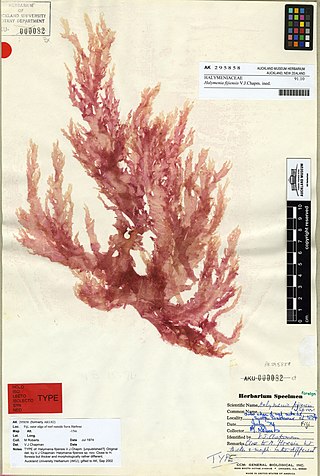
Halymeniales is an order of red algae belonging to the class Florideophyceae and the subclass Rhodymeniophycidae.
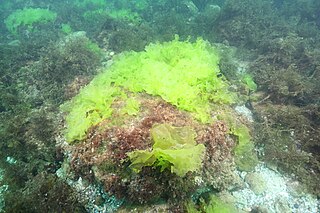
Ulva rigida is a species of green algae in the family Ulvaceae. The species prefers eutrophic environments.

Galaxaura rugosa is a species of red algae in the family Galaxauraceae. The species is the type species of its genus, Galaxaura. The species is found in the Pacific and Indian oceans, Gulf of Mexico, Caribbean Sea, and Macaronesia.
